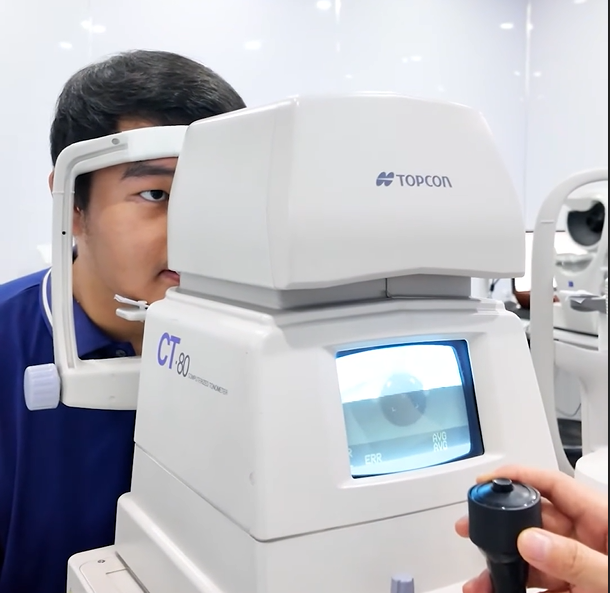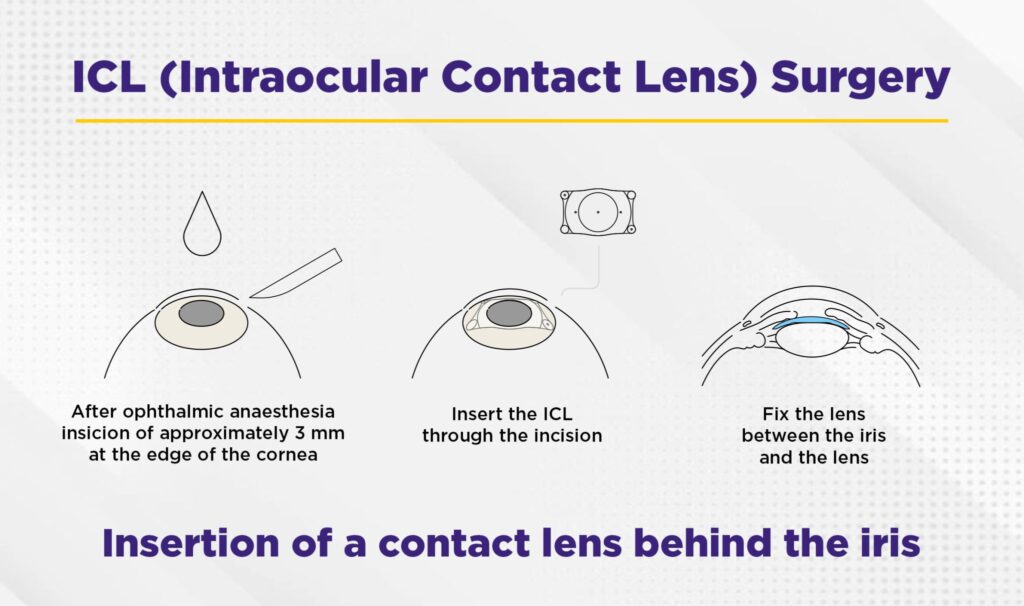Introduction
Phakic ICL – A Modern Solution for Myopia and Astigmatism

The team of medical specialists at Viet An Eye Hospital Da Nang
Phakic ICL (Implantable Collamer Lens) is a biocompatible intraocular lens placed behind the iris and in front of the natural lens. Unlike corneal laser procedures, Phakic ICL does not damage the cornea, making it especially beneficial for patients with high myopia, thin corneas, or dry eyes.
Ideal Candidates
- Myopia from –3.0D to –20.0D, with astigmatism 1.0D – 4.0D.
- Ages 21–45, stable refraction ≥ 1 year.
- No severe ocular conditions (advanced glaucoma, intraocular inflammation, retinal diseases, etc.).
- Wants to preserve corneal structure with fast recovery.
Eligibility depends on preoperative screening (anterior chamber depth, endothelial cell count, pupil size, lens power, etc.). A thorough eye exam is required for personalized advice.
Outstanding Advantages of Phakic ICL
Quick Comparison
| Criteria | Phakic ICL | LASIK | PRK |
|---|---|---|---|
| Corneal impact | No | Yes (flap & ablation) | Yes (surface ablation) |
| Dry eye risk | Very low | Common | Common |
| High myopia correction (up to –20D) | Yes | Limited | Limited |
| Removability | Yes, if needed | No | No |
| UV protection | Yes (Collamer material) | No | No |
| Recovery time | Fast (1–2 days) | Fast (a few days) | Longer (weeks) |
Key Highlights

The Phakic ICL lens made from Collamer™ – a biocompatible material friendly to the eye
Near-immediate vision improvement
After Phakic ICL surgery, most patients achieve functional vision within 24–48 hours. Clinical studies show over 90% of patients reach uncorrected vision equal to or better than their preoperative corrected vision.
Very fast recovery
The Phakic ICL implantation takes only 20–30 minutes, outpatient, with patients returning to daily life within 1–2 days. Compared to PRK or LASIK, which require longer corneal healing, this minimizes disruption to work and lifestyle.
Minimal dry eye risk
Unlike LASIK or PRK, ICL does not cut corneal tissue or nerves, preserving tear function and significantly reducing the risk of postoperative dry eye – especially important for patients already suffering from dry eye.
Stable night vision
Patients report excellent night vision. The Collamer lens optimizes light transmission, reducing glare and halos typically associated with corneal laser surgery.
UV protection & biocompatibility
The Phakic ICL is made of Collamer™, a collagen-based biocompatible material that naturally filters UV rays. Patients do not feel or see the lens once implanted.
Long-term flexibility
Phakic ICL can be removed if refractive needs change, new technology becomes available, or cataract surgery is required in the future – offering reassurance without permanently altering the cornea.
Proven effectiveness
Approved by the FDA, Phakic ICL has been used for over 30 years with more than 3 million lenses implanted worldwide. Patient satisfaction is exceptionally high, with over 99% saying they would choose the procedure again.
Important Notes Before – During – After Surgery

Patients undergoing vision correction surgery at Viet An Eye Hospital
Before surgery
Patients must discontinue contact lenses for accurate measurements: soft lenses for 2 weeks, rigid lenses for 3–4 weeks. Before Phakic ICL surgery, the doctor will conduct a full preoperative exam including anterior chamber depth, angle width, axial length, sulcus size and endothelial cell density. Lifestyle factors such as profession, sports, and night work will be discussed to choose the best lens option.
During and immediately after surgery
Phakic ICL surgery is performed under local anesthesia, quick and painless. Temporary blurred vision may occur from pupil dilation or intraocular fluid, but typically improves within 24–48 hours. Patients must not drive on the day of surgery and should arrange transportation.
Follow-up and periodic exams
Follow-ups are usually scheduled at Day 1, Week 1, Month 1, Month 3, Month 6 and thereafter. Monitoring intraocular pressure is critical, as some patients may experience early IOP elevation due to viscoelastic or aqueous flow changes. Regular endothelial cell counts are also necessary to ensure long-term corneal health.
Possible risks (low incidence but important)
- Intraocular pressure rise: usually early and manageable if detected promptly.
- Cataract over time: higher risk in very high myopia or older patients; can be treated with phacoemulsification and ICL removal.
- Endothelial cell loss: requires long-term monitoring; intervention if density falls below safety limits.
- Glare and halos: may appear initially, often diminishing after weeks to months as vision stabilizes.
Maintain eye hygiene, follow prescribed medication, avoid rubbing eyes for 3–5 days; limit swimming and eye makeup for 1–2 weeks. Contact your doctor immediately if you experience pain, redness, or sudden vision loss.
Conclusion & Next Steps
Phakic ICL represents a major advancement in refractive surgery, especially for patients with high myopia, thin corneas, or dry eyes. Performed by experienced surgeons such as Dr. Huynh Quoc Vu, the procedure delivers sharp vision, rapid recovery, reduced dry eye risk, and long-term flexibility.
For further information, you can explore TD Eye’s knowledge hub on ophthalmology or read the detailed overview of Phakic ICL.

 vi
vi 28-Aug-2025
28-Aug-2025
.svg) Hotline
Hotline Appointment
Appointment https://matvietandn.vn/
https://matvietandn.vn/ 115 Nguyễn Văn Linh, Hải Châu, Da Nang City
115 Nguyễn Văn Linh, Hải Châu, Da Nang City Opening Hours
Opening Hours






